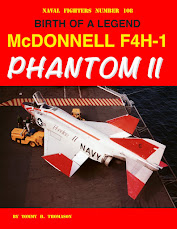Warren Eberspacher created a set of drawings in the early 1970s that appeared in issues of Air Classics and the American Aviation Historical Society Journal. For some reason, he shortened the distance between the wing and the empennage along with making other detail errors. The Lloyd Jones drawings in Bert Kinzey's D&S Volume 55 contain the same fuselage length error. Japanese illustrators Hidel Maki and Riku Watanabe got the length right but not the subtle change in fuselage depth aft of the cockpit.
Another wrinkle is that the modifications were made to the prototype over time. For example, after the July 1940 crash, the engine was moved about 4.5 inches forward, which can be discerned from close examinations of before and after pictures, and the exhaust stack fairing was modified. I show the later cowling in the side view above.
David Weeks reminded me about the propeller change that probably occurred during the post crash rebuild:
I was aware of the difference in ailerons between the prototype and production Corsairs, but the rudder and elevators were also different, at least initially: the rudder's aerodynamic balance did not extend as far forward and the elevator was broader in chord. I don't know exactly when these were modified, but it appears that the rudder change was accomplished before the elevator change. In this picture, the XF4U has the production rudder but the elevator has not yet been changed.
In this picture, taken after the elevator change, you can still see the fairings on the tail cone for the larger elevator.
Note the tube extending out of the fuselage for the spin chute installation. The XF4U had a stinger-type tail hook that was installed initially and also for shore-based testing but in most pictures, the spin-chute tube is present.
Another notable difference between the XF4U-1 and the production Corsairs was the shape of the cooler inlet in the leading edge of the wing.
Note the angled panel line outboard of the inlet on the production Corsair.
Whereas the oil cooler was partially hidden by the production inlet, it was not in the prototype's:
I also added various details to the top view and a scrap bottom view of the left wing from pictures.
I'm pretty sure that the size and location of the downward vision window is correct. For a description of the anti-aircraft bomb concept, see http://thanlont.blogspot.com/2008/06/antiaircraft-bombs.html. The water sensor on the bottom of the wing automatically deployed the flotation bags.
The prototype had a more complex flap system than the production airplanes, with a small span-wise fore flap above the leading edge of the main flap. This created a double slot arrangement that was not carried forward to production.
National Archives via Joe Hegedus
Note the 360-degree cowl flaps. The picture was taken pre-crash, so the airplane has the short cowling, smaller aero balance on the rudder, big elevator, and propeller with the tapered tip. It is also one of the few pictures taken when the tailhook was installed.
The XF4U-1 was evaluated with both 9.5 and 5 degrees of aileron droop.
Any benefit to stall speed was more than offset by the higher aileron control forces in the landing configuration.
David Weeks wrote and illustrated an article about his excellent conversion of a Tamiya's 1/48 F4U-1 "birdcage" into an XF4U-1 in the January/February 2011 issue of the IPMS/USA Journal (also see http://www.hyperscale.com/2009/features/xf4u148dw_1.htm). Although he used the Jones' drawing, the fuselage length error is not at all evident. The October 2004 issue of FineScale Modeler has an illustrated description of Paul Boyer's equally excellent conversion of Hasegawa's 1/72 F4U-1 "birdcage".
There is pretty complete coverage of the XF4U-1 cockpit in the comprehensive guide to the Corsair by Rafe Morrissey and Joe Hegedus (see http://www.sampublications.com/books/modellers-datafile/f4u-corsair/prod_21.html or http://www.squadron.com/The-Vought-F4U-Corsair-SC-SAM-Publications-p/sa5912.htm). For some reason, the left console wasn't included, so here it is:
More later,
















Nice! Excellent details of a XF4U-1! Tks for sharing it.
ReplyDelete